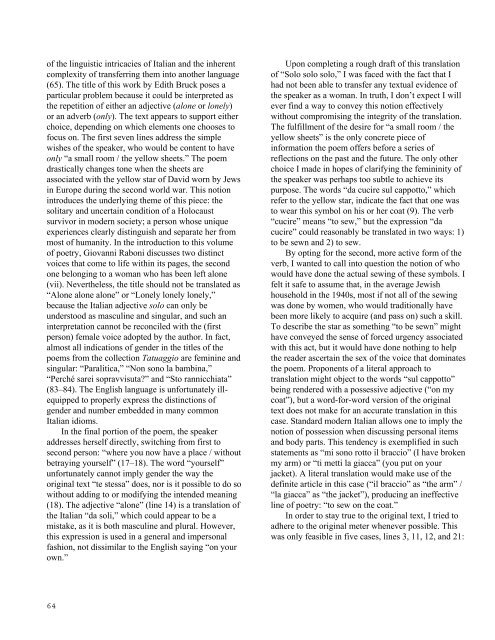their - The University of Texas at Dallas
their - The University of Texas at Dallas
their - The University of Texas at Dallas
You also want an ePaper? Increase the reach of your titles
YUMPU automatically turns print PDFs into web optimized ePapers that Google loves.
<strong>of</strong> the linguistic intricacies <strong>of</strong> Italian and the inherent<br />
complexity <strong>of</strong> transferring them into another language<br />
(65). <strong>The</strong> title <strong>of</strong> this work by Edith Bruck poses a<br />
particular problem because it could be interpreted as<br />
the repetition <strong>of</strong> either an adjective (alone or lonely)<br />
or an adverb (only). <strong>The</strong> text appears to support either<br />
choice, depending on which elements one chooses to<br />
focus on. <strong>The</strong> first seven lines address the simple<br />
wishes <strong>of</strong> the speaker, who would be content to have<br />
only “a small room / the yellow sheets.” <strong>The</strong> poem<br />
drastically changes tone when the sheets are<br />
associ<strong>at</strong>ed with the yellow star <strong>of</strong> David worn by Jews<br />
in Europe during the second world war. This notion<br />
introduces the underlying theme <strong>of</strong> this piece: the<br />
solitary and uncertain condition <strong>of</strong> a Holocaust<br />
survivor in modern society; a person whose unique<br />
experiences clearly distinguish and separ<strong>at</strong>e her from<br />
most <strong>of</strong> humanity. In the introduction to this volume<br />
<strong>of</strong> poetry, Giovanni Raboni discusses two distinct<br />
voices th<strong>at</strong> come to life within its pages, the second<br />
one belonging to a woman who has been left alone<br />
(vii). Nevertheless, the title should not be transl<strong>at</strong>ed as<br />
“Alone alone alone” or “Lonely lonely lonely,”<br />
because the Italian adjective solo can only be<br />
understood as masculine and singular, and such an<br />
interpret<strong>at</strong>ion cannot be reconciled with the (first<br />
person) female voice adopted by the author. In fact,<br />
almost all indic<strong>at</strong>ions <strong>of</strong> gender in the titles <strong>of</strong> the<br />
poems from the collection T<strong>at</strong>uaggio are feminine and<br />
singular: “Paralitica,” “Non sono la bambina,”<br />
“Perché sarei sopravvisuta” and “Sto rannicchi<strong>at</strong>a”<br />
(83–84). <strong>The</strong> English language is unfortun<strong>at</strong>ely illequipped<br />
to properly express the distinctions <strong>of</strong><br />
gender and number embedded in many common<br />
Italian idioms.<br />
In the final portion <strong>of</strong> the poem, the speaker<br />
addresses herself directly, switching from first to<br />
second person: “where you now have a place / without<br />
betraying yourself” (17–18). <strong>The</strong> word “yourself”<br />
unfortun<strong>at</strong>ely cannot imply gender the way the<br />
original text “te stessa” does, nor is it possible to do so<br />
without adding to or modifying the intended meaning<br />
(18). <strong>The</strong> adjective “alone” (line 14) is a transl<strong>at</strong>ion <strong>of</strong><br />
the Italian “da soli,” which could appear to be a<br />
mistake, as it is both masculine and plural. However,<br />
this expression is used in a general and impersonal<br />
fashion, not dissimilar to the English saying “on your<br />
own.”<br />
Upon completing a rough draft <strong>of</strong> this transl<strong>at</strong>ion<br />
<strong>of</strong> “Solo solo solo,” I was faced with the fact th<strong>at</strong> I<br />
had not been able to transfer any textual evidence <strong>of</strong><br />
the speaker as a woman. In truth, I don’t expect I will<br />
ever find a way to convey this notion effectively<br />
without compromising the integrity <strong>of</strong> the transl<strong>at</strong>ion.<br />
<strong>The</strong> fulfillment <strong>of</strong> the desire for “a small room / the<br />
yellow sheets” is the only concrete piece <strong>of</strong><br />
inform<strong>at</strong>ion the poem <strong>of</strong>fers before a series <strong>of</strong><br />
reflections on the past and the future. <strong>The</strong> only other<br />
choice I made in hopes <strong>of</strong> clarifying the femininity <strong>of</strong><br />
the speaker was perhaps too subtle to achieve its<br />
purpose. <strong>The</strong> words “da cucire sul cappotto,” which<br />
refer to the yellow star, indic<strong>at</strong>e the fact th<strong>at</strong> one was<br />
to wear this symbol on his or her co<strong>at</strong> (9). <strong>The</strong> verb<br />
“cucire” means “to sew,” but the expression “da<br />
cucire” could reasonably be transl<strong>at</strong>ed in two ways: 1)<br />
to be sewn and 2) to sew.<br />
By opting for the second, more active form <strong>of</strong> the<br />
verb, I wanted to call into question the notion <strong>of</strong> who<br />
would have done the actual sewing <strong>of</strong> these symbols. I<br />
felt it safe to assume th<strong>at</strong>, in the average Jewish<br />
household in the 1940s, most if not all <strong>of</strong> the sewing<br />
was done by women, who would traditionally have<br />
been more likely to acquire (and pass on) such a skill.<br />
To describe the star as something “to be sewn” might<br />
have conveyed the sense <strong>of</strong> forced urgency associ<strong>at</strong>ed<br />
with this act, but it would have done nothing to help<br />
the reader ascertain the sex <strong>of</strong> the voice th<strong>at</strong> domin<strong>at</strong>es<br />
the poem. Proponents <strong>of</strong> a literal approach to<br />
transl<strong>at</strong>ion might object to the words “sul cappotto”<br />
being rendered with a possessive adjective (“on my<br />
co<strong>at</strong>”), but a word-for-word version <strong>of</strong> the original<br />
text does not make for an accur<strong>at</strong>e transl<strong>at</strong>ion in this<br />
case. Standard modern Italian allows one to imply the<br />
notion <strong>of</strong> possession when discussing personal items<br />
and body parts. This tendency is exemplified in such<br />
st<strong>at</strong>ements as “mi sono rotto il braccio” (I have broken<br />
my arm) or “ti metti la giacca” (you put on your<br />
jacket). A literal transl<strong>at</strong>ion would make use <strong>of</strong> the<br />
definite article in this case (“il braccio” as “the arm” /<br />
“la giacca” as “the jacket”), producing an ineffective<br />
line <strong>of</strong> poetry: “to sew on the co<strong>at</strong>.”<br />
In order to stay true to the original text, I tried to<br />
adhere to the original meter whenever possible. This<br />
was only feasible in five cases, lines 3, 11, 12, and 21:<br />
64

















